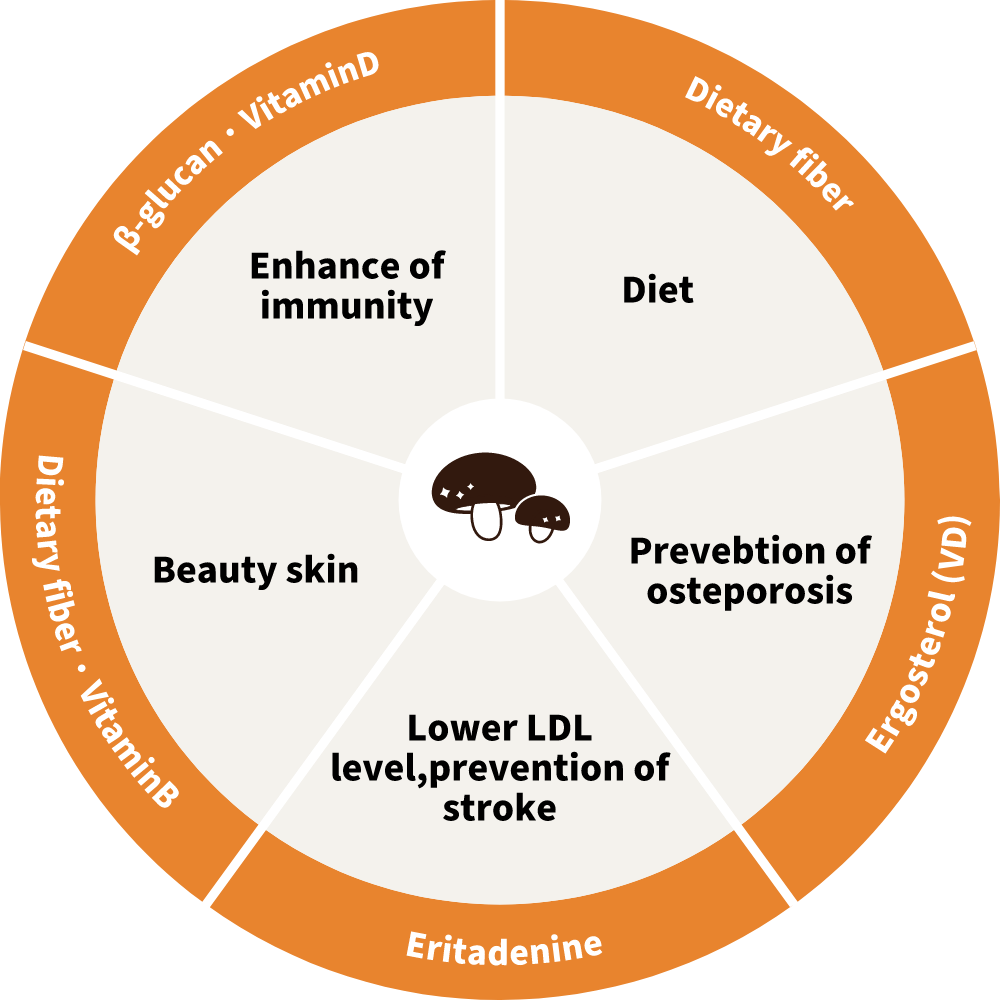What is wood log shiitake
Wood log shiitake
Environmental conservation and biodiversity
-
“Reforestation”
For the cultivation of shiitake mushrooms, we use broad-leaved trees such as oak, which is 15 to 20 years old. In the felled forest, new shoots sprout from the stump. They grow vigorously again while actively absorbing CO2. Forests in good condition are thus maintained by recycling. By growing and consuming log shiitake mushrooms, we contribute to protecting forests and preventing global warming.
However, the use of satoyama trees is rapidly declining due to the disappearance of the use of firewood and charcoal as fuel, as well as the reduction of production of raw wood shiitake mushrooms. As a result, the number of broad-leaved forests and mountains that have been left uncut for many years has increased year by year, causing pine wilt and oak wilt, and the natural blessings of satoyama and various environmental protection functions have begun to be destroyed. Such phenomena are becoming new environmental and social problems. -
“Protect biodiversity”
In broad-leaved forests, there are many species that bear nuts such as acorns in the fall. They provide a very valuable food for wild animals. On the other hand, the forest provides a space where wild animals and other creatures of various sizes can live with peace of mind. And in the forest, there are many microorganisms such as mushrooms that clean fallen leaves, fallen trees, animal droppings and carcasses. They do an important job of breaking down organic matter and reducing it to inorganic matter. This keeps the forest sustainable and renewable.
Yes, the forest supports the lives of so many creatures with its blessings, and at the same time, the health of the forest is maintained by a wide variety of creatures. Rich forests are truly a symbol of biodiversity.
-
“Enrich the sea”
Healthy forests and mountains have a dam function to store rainwater. They are not only safe and tasty drinking water, but also a stable source of water to irrigate downstream fields and support agriculture.
By the way, did you know that the secret of the rich sea lies in the forest?
When hardwood forests fall, many leaves and nuts fall to the ground. Eventually, it is broken down by fungi such as mushrooms into minerals and nutrients, which are then transported underground and through rivers to the sea with rain. It then breeds phytoplankton, which feeds sea creatures, and grows a lot of delicious shellfish, shrimp, and fish.
"I protect this forest and the sea," a log shiitake grower proudly told me.
"I am protecting this forest and the sea." the grower of the log shiitake told me proudly.
Contribution to food
-
Japanese cultivated mushrooms such as shiitake, king oyster mushrooms, maitake , and enoki mushrooms are gaining popularity overseas as food. Above all, the deliciousness of shiitake mushrooms is now widely recognized all over the world.
The shiitake mushroom contains more umami component called guanylic acid than other mushrooms, in addition to glutamic acid, which is a typical taste component.
Recent studies have reported that guanylic acid has the effect of enhancing human taste sensation.
In other words, when you eat foods containing guanylic acid and glutamic acid (seaweed, vegetables, etc.) or inosinic acid (meat, fish, etc.) together, the synergistic effect dramatically enhances the taste.
In other words, by cooking mushrooms such as shiitake mushrooms with various ingredients, you can expect to improve the taste of the dish several times.
Perhaps mushrooms such as shiitake mushrooms can be said to be super seasonings that enhance the taste of all dishes in the world.
Contribution to health

Mushrooms have long been widely used in foods and as traditional medicines for many illnesses. It is now recognized as a beneficial food for maintaining and improving health. Mushrooms are rich in polysaccharides, especially β-glucan, which are said to be effective for health and longevity and treatment of diseases, and are characterized by being a food that activates immunity. Mushrooms are also popular as health foods because they are high in dietary fiber and low in calories.
In addition to these polysaccharides, it contains essential amino acids, minerals, vitamins such as thiamine and pyridoxine, and various components such as ergosterol and vitamin D2, so it has a wide range of pharmacological actions and is effective in preventing various diseases. You can expect it. In addition, mushrooms are high in phenols, so they are also antioxidant foods.
From these components, the pharmacological action of mushrooms is antioxidative action, blood pressure lowering action, cholesterol lowering action, hepatoprotective action, anti-inflammatory action, antidiabetic action, antiviral action, antibacterial action, etc. It is known that there is. In addition, mushrooms do not have strong pharmacological actions and immediate effects like drugs, but have no side effects.
Therefore, to maintain good health, it is important to eat a well-balanced diet regularly.
And instead of expecting dramatic medicinal effects, it is recommended that you eat healthy mushrooms every day to help prevent lifestyle-related diseases.

